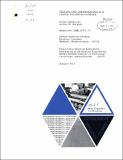| dc.contributor.author | Bar-Cohen Avram | en_US |
| dc.contributor.author | Bergles A. E. | en_US |
| dc.contributor.other | Massachusetts Institute of Technology. Division of Sponsored Research. | en_US |
| dc.contributor.other | Massachusetts Institute of Technology. Dept. of Mechanical Engineering. | en_US |
| dc.contributor.other | Massachusetts Institute of Technology. Heat Transfer Laboratory. | en_US |
| dc.date.accessioned | 2011-03-04T23:26:54Z | |
| dc.date.available | 2011-03-04T23:26:54Z | |
| dc.date.issued | 1971 | en_US |
| dc.identifier | 14120894 | en_US |
| dc.identifier.uri | http://hdl.handle.net/1721.1/61446 | |
| dc.description.abstract | A combined experimental and analytical investigation of boiling and condensation in a liquid-filled enclosure, with water and Freon- 113 as the working fluids, is described. The operating characteristics of a boiling system, utilizing a condenser submerged in the fluid, are presented and related to specific operational modes and thermal transport mechanisms. A lower bound of operation, corresponding to natural convection heat transfer at both the heated and condenser surfaces, is identified. Similarly, for the commonly encountered range of system operation, a condensive upper bound is identified and shown to correspond to vapor space condensation. A nondimensional vapor bubble collapse length, L c/W, is found to govern the rate and mechanism of heat transfer at the submerged condenser surface. LValues of wC << are associated with natural convection heat transfer at the L c submerged condenser. For -~ I the presence of a substantial vapor frac- w tion in the bulk liquid leads to augmented convection, while for values of L C >> 1 condensation is found to dominate thermal transport at the condenser surface. 4 possible technique for augmenting condensation heat transfer on horizontal surfaces is examined in an attempt to raise the condensive upper bound of submerged condenser operation. A doubly-rippled surface with small, constant radius of curvature undulations is shown to yield a factor of two increases in the rate of vapor space condensation based on the projected area of the condenser surface. | en_US |
| dc.description.abstract | (cont.) A systematic design procedure for submerged condenser systems utilizing the proposed models and correlations is described and related to typical design considerations. | en_US |
| dc.format.extent | x, 106 leaves | en_US |
| dc.publisher | Cambridge, Mass. : M.I.T. Heat Transfer Laboratory, [1971] | en_US |
| dc.relation.ispartofseries | Technical report (Massachusetts Institute of Technology, Heat Transfer Laboratory) ; no. 73. | en_US |
| dc.subject | Boiling-points. | en_US |
| dc.subject | Condensation. | en_US |
| dc.subject | Heat -- Transmission. | en_US |
| dc.title | Boiling and condensation in a liquid-filled enclosure | en_US |
| dc.type | Technical Report | en_US |
